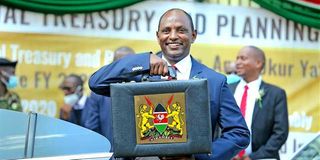The problem with Yatani’s economic growth projections

Treasury Secretary Ukur Yatani when he arrived at parliament buildings on June 11, 2020 to table Sh3.2 trillion Budget. PHOTO | RAPHAEL NJOROGE | NATION MEDIA GROUP
What you need to know:
- Taking into account the health and economic shocks, the State’s projected economic growth for 2020 and 2021 is 2.5 per cent and 5.4 per cent, respectively.
- Yet the State’s budget for 2020/21 features expanding recurrent expenditure that accounts for roughly 65 per cent of aggregate public outlays characterised by a huge wage bill fraught with rising debt servicing costs.
- So, how does the State expect to realise the intended economic performance using the same expenditure framework?
Emerging and developing economies have endured various extraneous shocks from the Covid-19 pandemic. The ensuing economic aftermath has led to a significant drop in foreign remittances, a decline in their commodity prices and a notable slump in export volumes due to the closure of border points and airports internationally.
As a result, countries have recorded negative GDP growth rates following a series of adverse socio-economic effects on livelihoods and individuals’ health. The circumstances have also created a constraint of borrowing shock. Simply put, this is the lack of confidence among foreign lenders in the ability of developing countries to service debt. For Kenya, besides the health shock, there are other internally generated shocks, specifically, severe floods and invasion by desert locusts.
Confronted with the new state of affairs, on June 11 the State unveiled its budget for the 2020/21 financial year, themed “Stimulating the Economy to Safeguard Livelihoods, Jobs, Businesses and Industrial Recovery”.
To avert a looming recession, the government presented an expansionary budget projected at Sh2.8 trillion, or 24.7 per cent of GDP, to resuscitate the economy. In light of the uncertainty about when the pandemic will be contained, the State’s anticipated public expenditure could shoot up to Sh3.2 trillion.
This represents a growth of 5.8 per cent from the previous year’s budget estimate of Sh3 trillion. The revenue collection target for the corresponding fiscal year is Sh1.6 trillion, which translates roughly to 58 per cent of the estimated budget. During the preceding year, Treasury’s fiscal consolidation measures geared towards reducing the fiscal deficit and accrual of debt were inhibited by multiple negative economic shocks.
For this reason, the fiscal deficit target for the 2020/21 financial year is Sh840 billion — or 8.3 per cent of GDP — from the previously anticipated target of 6.3 per cent of GDP. As a result, the State will borrow Sh823 million for budgetary support.
In 2019, Kenya’s debt-to-GDP ratio stood at 62 per cent, against the recommended EAC threshold of 50 per cent. In comparison to peer countries over the same period, Uganda’s and Tanzania’s total national debt-to-GDP ratio stood at 37.2 and 37.7 per cent, respectively.
The Budget Statement for the 2020/21 financial year allocates Sh633 billion for development expenditure, which translates to 22.7 per cent of the proposed aggregate government expenditure. The State’s fiscal responsibility principles, set out in section 15 of the 2012 Public Finance Management Act, outline what should apply to the management of public funds. Pursuant to section 15(5) of the PFM Act, the national government expenditure on development should be at least 30 per cent in line with the requirement under section 15(2) (a) of the Act.
Between 2018/19 and 2019/20, the 2020 Economic Survey shows, the share of development outlays to total public spending was 19.3 and 24.8 per cent, respectively. Thus, development expenditure continues to fall below the intended threshold. The proposed recurrent outlays for the fiscal year are Sh1.8 trillion. Recurrent spending consists of domestic and foreign interest outflows, pensions, wages and salaries, operation and maintenance costs.
In 2018/19 and 2019/20 recurrent spending as a ratio of total public spending was 80.7 and 75.2 per cent, respectively, while between 2018 and 2019 the public sector wage bill stood at Sh604.3 billion and Sh669.6 billion, a Sterling Capital Research report shows. On average, the share of recurrent spending on wages to aggregate public expenditure was 40 per cent for both periods.
In light of the pandemic, the budget ought to have presented well-defined objectives designed to boost sustainable economic recovery.
Unprecedented emergencies call for exceptional policies. The State should rethink its fiscal stance to support the most vulnerable in society and provide the capital needed to enhance the productive capacity of the economy.
The 2012 PFM Act specifies that the government’s expenditure on remuneration, including benefits and allowances, should not exceed 35 per cent of its equitable share of revenue raised nationally plus other revenues generated in line with Article 209 (4) of the Constitution.
Taking into account the health and economic shocks, the State’s projected economic growth for 2020 and 2021 is 2.5 per cent and 5.4 per cent, respectively. Yet the State’s budget for 2020/21 features expanding recurrent expenditure that accounts for roughly 65 per cent of aggregate public outlays characterised by a huge wage bill fraught with rising debt servicing costs. So, how does the State expect to realise the intended economic performance using the same expenditure framework?
Ms Nguyu is an economist; [email protected]




